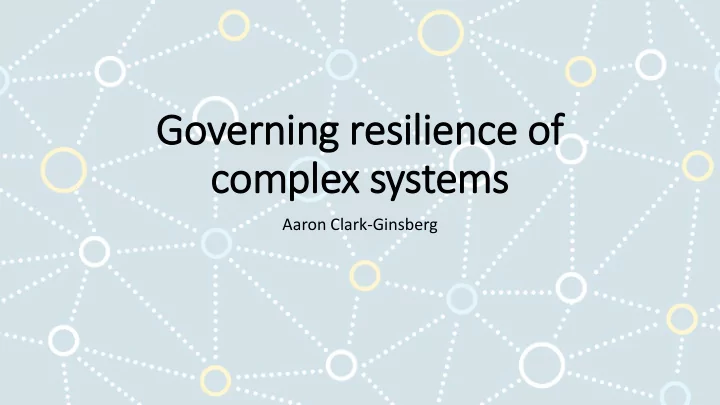

Go Govern rning r g resilience o of co comp mplex s systems ms Aaron Clark-Ginsberg
Flooding in Freetown, Sierra Leone as a complex problem. Not just technical (floodwalls) but also organisational. Contributes to other risks.
Actors involved in managing Freetown, Sierra Leone. Massive institutional environment.
Pillbox used during WW II as a guard station in Bonneville power plant in Washington. Securing our critical infrastructure used to be simple.
Today our electric grid is much more complex. Security involves managing information and the people who manage information (socio-technical).
Complex risks are endemic to modern society. We need to learn how to manage complex risks. We can’t employ the same tools for managing simple risks (like quantification, linear governance). That’s like bringing a knife to a gun fight. We need to work with complexity and embrace complexity.
You’re trying to manage risks in a complex socio-technical system. Here’s how you do it: • tight coupling and complexity create ‘normal accidents’, where it’s impossible to fully manage risk • Some risks, however, are governance failures and maligned incentives methods for governing risk 1. Limit complexity-simplify 2. Embrace complexity and seek to manage it (resilience/high reliability) 3. Change governance structures to incentivize risk reduction, security, and safety Resilience: the ability “to anticipate, absorb, adapt to, and/or rapidly recover from a potentially disruptive event” (National Infrastructure Advisory Council, 2009, 8)
limiting complexity and interconnections with rules and standards 1. Can help reduce complexity and quantify risks 2. Can reduce systemic risks 3. Complexity might always be there 4. Not completely representative of the ‘real world’ all the time—an approximation Impact of technological change on risk Regulations and risk: control to limit complexity and change behavior
Managing risks and building a high reliability organization Characteristics of a ‘high reliability organization’ • Preoccupation with failure. • Reluctance to simplify interpretations. • Sensitivity to operations. • Commitment to resilience. • Deference to expertise. • Firefighters, industrial control room operators, pastoralists in Kenya, emergency room staff, flight crews, all operate well under pressure. They also have characteristics of a high reliability organization • They exceed in managing risk. They are not failure free though!
Managing risk: local scalable emergency management for health crisis in dryland Kenya (the Surge model) Dryland health crises can scale up and down rapidly and erratically. The surge model is designed as a Surveillance tool • Response tool • Tool to reflect local • institutional structure
Incident command system and wildfire risk firefighters have an obligation to fight fire efficiently and safely… a contradiction: in training they say "If you just THINK you may need help, call for it. Get the trucks on the road, we can always turn them around. No one will think any less of you" that is the biggest lie in the fire service. Call for one ounce more resources then the monday morning quarterbacks with the benefit of 20/20 hindsight, think you should have-- and you will be mocked and ridiculed for quite a while... of course it is "all in good fun", which is the statement of last refuge for pea-brained quasi-bullys who populate every department that I have ever been part of
Control center operations • Provide birds eye view of a system • Work as a team to maintain reliability • Sometimes face competing values of reliability, security, economic efficiency. This compromises their reliability
Takeaways • Managing complex systems is a technical and organizational problem • Reducing complexity, improving organizational values, and creating agile response structure can help manage risks • It is impossible to completely quantify complex systems because of unknown unknowns. • Failures will occur. This necessitates impact reduction (preparedness, reducing scale) • Resilience is a good organizing lens for risk management
Recommend
More recommend